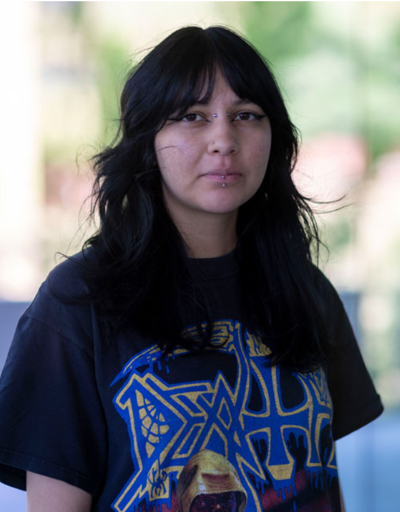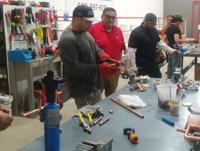
Jarenni Ambriz will attend Columbia University this fall on a full scholarship as a Ph.D. candidate in ethnomusicology, with a focus on heavy metal music.
Ambriz is graduating with a Bachelor of Arts in Asian and Asian American Studies (AAAS) from Cal State LA.
Heavy metal and Asian studies may not appear to be interrelated, but Ambriz sees an important common thread.
“Going back to the framework in Asian studies, a lot of it is about imperialism and power dynamics between institutions,” said the 22-year-old South Central resident. “In heavy metal, you also see these power dynamics within the lyrics, whether the songs are about gun control, or police brutality, or even talking about things like Agent Orange. The lyrics of heavy metal critique society. So, what I’m learning in my [undergraduate] major I see in […] music as well.”
Ambriz first became interested in Asian history after viewing a documentary on the Cambodian genocide under the Khmer Rouge regime from the mid- to late-1970s. One video led to another, and Ambriz’s curiosity was piqued.
“A first-generation college student raised in Los Angeles, Jarenni Ambriz is among the most impressive Asian and Asian American Studies majors at Cal State LA,” said Wei-Lun Jason Chiu, AAAS assistant professor. “Guided by her tenacious spirit and natural inquisitiveness, she aligned her personal and academic interests to produce outstanding research. A longtime fan of heavy metal music, particularly death metal, her research interrogates the intersection between entrepreneurship, music, race and power dynamics within the music industry.”
Ambriz said the videos of developing Southeast Asian and South Asian countries reminded her of her parents’ native Mexico, where she lived between the ages of nine and 13.
“All throughout high school, I was really interested in Asian history, specifically in the U.S. intervention in Southeast Asia during the Cold War,” she said. “I was really interested in Cambodia and how the genocide was a byproduct of the U.S. intervention in Vietnam and Southeast Asia.”
She and her older sister Janerri, along with their mother, moved to Tuxpan, Nayarit, to stay with their paternal grandmother when their mother fell ill with cancer. Their mother passed away three weeks after their relocation.
Her mother’s death marked the beginning of four tumultuous years. Ambriz said it seemed like she was living with strangers as she and her sister did not previously know their relatives in Mexico. She felt neglected, as her grandmother was too old and frail to care for her and her sister, leaving their upbringing to a cast of aunts who rotated in and out of their grandmother’s house.
Ambriz, who had always loved school, said she made no academic progress while attending under-resourced schools in Mexico. Her quiet demeanor made her an easy target for bullies.
She points to this difficult period as to why she chose AAAS as her major, as opposed to, say, Chicana/o and Latina/o Studies.
“I’m asked that question a lot,” she said. “I had a lot of traumas, and I didn’t want to do any research about Mexico. I didn’t want to relive all that.”
She developed a passion for heavy metal shortly after she returned from Mexico, which was roughly the same time she became interested in Asian history.
Majoring in AAAS gave her enough distance from her painful experiences, but the parallels she saw between Mexico and some Asian countries provided her a sense of the colonial history of Mexico, even if she was learning it from the lens of people from the opposite side of the world.
And now Ambriz has come full circle as her undergraduate research in heavy metal involves local bands, including Mexican American bands, who go to Mexico to share their music.
“Ethnic studies are about giving accessibility to these groups that we’re learning about,” Ambriz said. “When you’re fighting oppression, you do it at the grassroots level. You have to reach out to local communities to fight. In many ways, ethnic studies influenced the work I want to do with heavy metal musicians.”
She wants to give the local musicians a voice.
Ambriz does not feature heavy metal artists that pack arenas and stadiums. Rather, they belong to the underground movement, performing in small venues, including warehouses and backyards.
They play for the love of music, and band members often hold day jobs to support their do-it-yourself weekend careers. When they are not gigging in Southern California, they are crossing the border to entertain fans in Tijuana and other points south.
“As an Asian and Asian American Studies major, Jarenni’s research on heavy metal music is importantly grounded in the local community,” Chiu said. “She carefully developed relationships with local metal bands during the interviews and fieldwork she conducted for her research project.”
Ambriz, who has worked as a student archivist in Special Collections and Archives at the University Library for the past three years, curated the library’s current display, "Metal in the Underground", featuring such local bands as Devour, Pagan Ritual and Mortalis.
“Heavy metal gave me the self-confidence I lacked,” she said. “I had gone through these life changes at such an early age and was really struggling. It was an escape. I felt like I was really connected to something.”










(0) comments
Welcome to the discussion.
Log In
Keep it Clean. Please avoid obscene, vulgar, lewd, racist or sexually-oriented language.
PLEASE TURN OFF YOUR CAPS LOCK.
Don't Threaten. Threats of harming another person will not be tolerated.
Be Truthful. Don't knowingly lie about anyone or anything.
Be Nice. No racism, sexism or any sort of -ism that is degrading to another person.
Be Proactive. Use the 'Report' link on each comment to let us know of abusive posts.
Share with Us. We'd love to hear eyewitness accounts, the history behind an article.